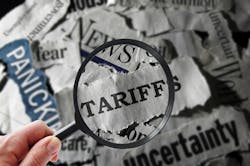Business Sentiment Snapshot: Industry Worries Skyrocket Ahead of Trump’s “Liberation Day” Tariff Announcements
During the first few months of his second term, President Donald Trump has pushed an extremely aggressive tariff policy, targeting U.S. allies and adversaries alike, a strategy that many in the business community have called erratic, as the president has continually delayed, reinstated, boosted and threatened various tariffs.
His most recent and bold proposition is sweeping reciprocal tariffs to be announced Wednesday, a day Trump has called “Liberation Day,” claiming on his Truth Social platform that other countries have been taking advantage of the U.S., and the tariff announcements will reshore manufacturing, making the country more independent.
Business Concerns
Corporate concerns about tariffs have crept into many economic indicators in recent weeks. Business leaders have complained about a lack of certainty due to the rapid changes, saying the back-and-forth announcements have made long-term planning difficult.
Business Sentiment Measurements
Corporate fears about upcoming tariffs have popped up in several recent surveys, including:
- Lehigh Business Supply Chain Risk Management Index
- IndustryWeek readership polls
- S&P Global Ratings
- Institute of Supply Management (ISM) surveys
Companies expect significantly higher risk to their supply chains in Q2, according to the Lehigh Business Supply Chain Risk Management Index (LRMI). LRMI collects survey data each quarter to gauge whether businesses expect supply chain risks to increase or decrease (more than 50 means higher risk, less than 50 means lower) for 10 categories in the upcoming quarter.
“The average risk score across all categories reached 72.14, the highest recorded in the last four years,” notes the report. In addition, nine of the 10 categories showed an increase in perceived risk for Q2.
“Supplier Risk” ranked number one and reached its highest level recorded since LRMI tracking began in 2020 with a score of 87.50. Respondents noted the inability to project long-term costs and volatility with suppliers and supply chains as consequences of tariffs.
“Four years ago, we obtained 60% of our product from China. By the end of this year, that number will be less than 5% as a result of tariffs and geopolitical issues,” wrote one respondent.
Another survey respondent reports “operational risks will rise exponentially due to the availability of spare parts and disruptions to the supply chain given how integrated we are from a global standpoint.”
“Government Intervention Risk” also ranked high on the LRMI report with a score of 80.52. Trump’s inconsistent strategy so far has created confusion on the parts of business trying to plan for the future.
“So far, there seems to be a on-again, off-again posturing regarding which tariffs take effect with which partners, on what commodities, and when would these take effect,” writes one respondent. “It would be better for our business if there were some clear ground rules to follow and we stuck with them. At least then, we would know clearly how to adapt our supply chains to address the global trade environment.”
This sentiment is echoed in responses to a recent IndustryWeek poll surrounding tariffs. “Not so concerned about tariffs themselves, but, more concerned about how they are implemented. There does not seem to be a consistent theme. Also, concerned about how the current strategy seems to be adversarial to some of the US' best trading partners,” writes an IW survey respondent.
Although the “Liberation Day” tariffs have yet to be announced, they are already having a real impact. “The threat of the tariffs and the international issues being created by the current political leadership is already starting to make it more difficult and costly to get repair parts and machinery,” wrote an LRMI respondent.
Despite challenges already arising, businesses are finding it difficult to plan due to the lack of transparency surrounding the tariffs.
“Most of the companies we work with are putting a pause to any significant work until after April 2. They are waiting for clarity,” writes one IW respondent.
Economic and Consumer Concerns
Tariffs are also slated to have a broad impact on the overall economy and costs. “Tariffs imposed or mooted by the U.S. and countermeasures by other countries are moving apace in 2025. This has weakened investor sentiment, consumer confidence, and should weigh on economic growth this year,” according to S&P Global Ratings’ Global Credit Conditions Q2 2025: Puzzling Reshuffling. “At the same time, global alliances and multinational institutions are being upended. The fundamental geopolitical changes at play will likely lead to material shifts in capital flows between regions, sectors, and asset classes.”
There is widespread concern for the overall economy, and it is being exacerbated by previously announced and upcoming trade policies.
“Several economic risks are increasing with deportations, border delays, tariffs and severe cuts to many critical government departments,” writes an LRMI respondent. “Also, inflation ticked up in Feb and most experts expect this to continue if Trump continues with major broad tariffs.”
If a significant portion of manufacturing operations are moved to the U.S. (one of Trump’s goals), this doesn’t mean manufacturers are out of the woods. LRMI respondents cite worries of price volatility and labor shortages if industry onshores.
“Tariffs will cause much long-term disruption, as suppliers and customers alike will have to navigate these new price structures,” writes an LRMI respondent.
“Customer Risk” reached a score of 75.63 on the LRMI Q2 report. “I expect that the tariffs will drive up prices and suppress growth. The uncertainty about the next move from the administration will also make business climate very cautious,” writes a respondent.
Consumer behavior, loss of business and the need to pass costs along to customers is a prevailing concern among respondents to the IW poll.
“Tariff announcements have created a surge of RFQs as our customers try to get ahead of the issue. We will support our best customers with tariff-free material as long as we can. At some point, we will be forced to pass the full tariff on to our customers,” writes an IW respondent.
In certain cases, companies have already had to resort to passing the cost along, with one IW respondent writing, “We are planning price hikes to minimize damage to margins, and in some cases already passing through raw material increases.”
In addition to higher prices, other issues stemming from tariffs will negatively impact inflation and the global economy, writes one IW respondent.
“The anticipated Trump Administration tariffs have arrived but are far from finalized, thus far resulting in protectionist measures by other countries and increased market volatility,” notes the S&P Global Ratings report. “Should current tariff levels persist or increase further, we would expect greater strain on consumer sentiment, business planning and investments, and government budgets leading to a reduction in our already compromised expectations for global growth this year.”
About the Author
Anna Smith
News Editor
News Editor
LinkedIn: https://www.linkedin.com/in/anna-m-smith/
Bio: Anna Smith joined IndustryWeek in 2021. She handles IW’s daily newsletters and breaking news of interest to the manufacturing industry. Anna was previously an editorial assistant at New Equipment Digest, Material Handling & Logistics and other publications.




